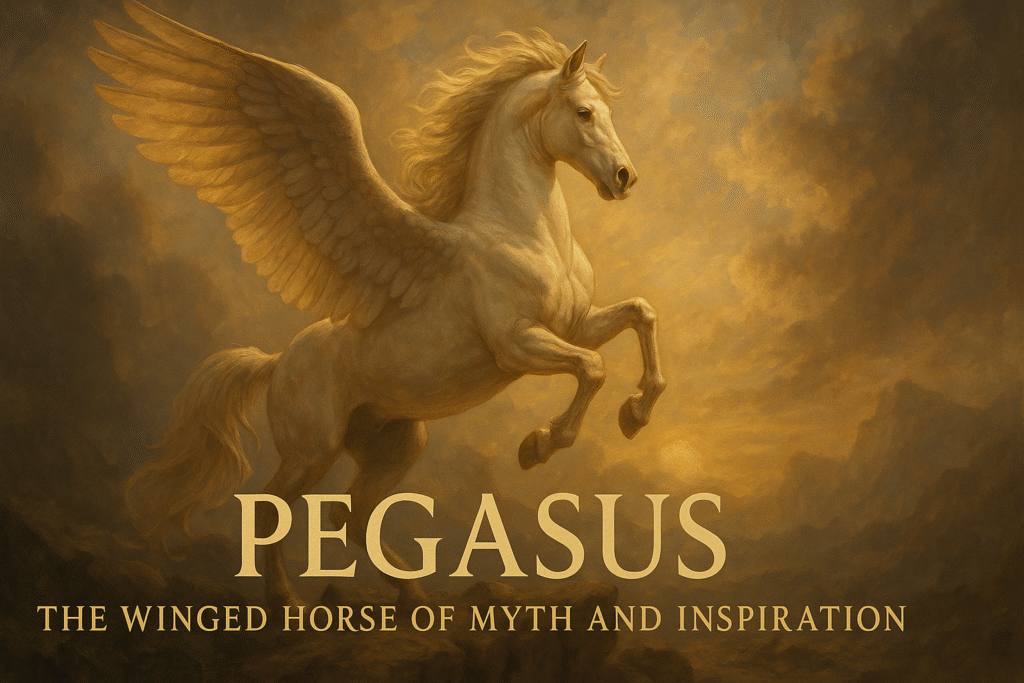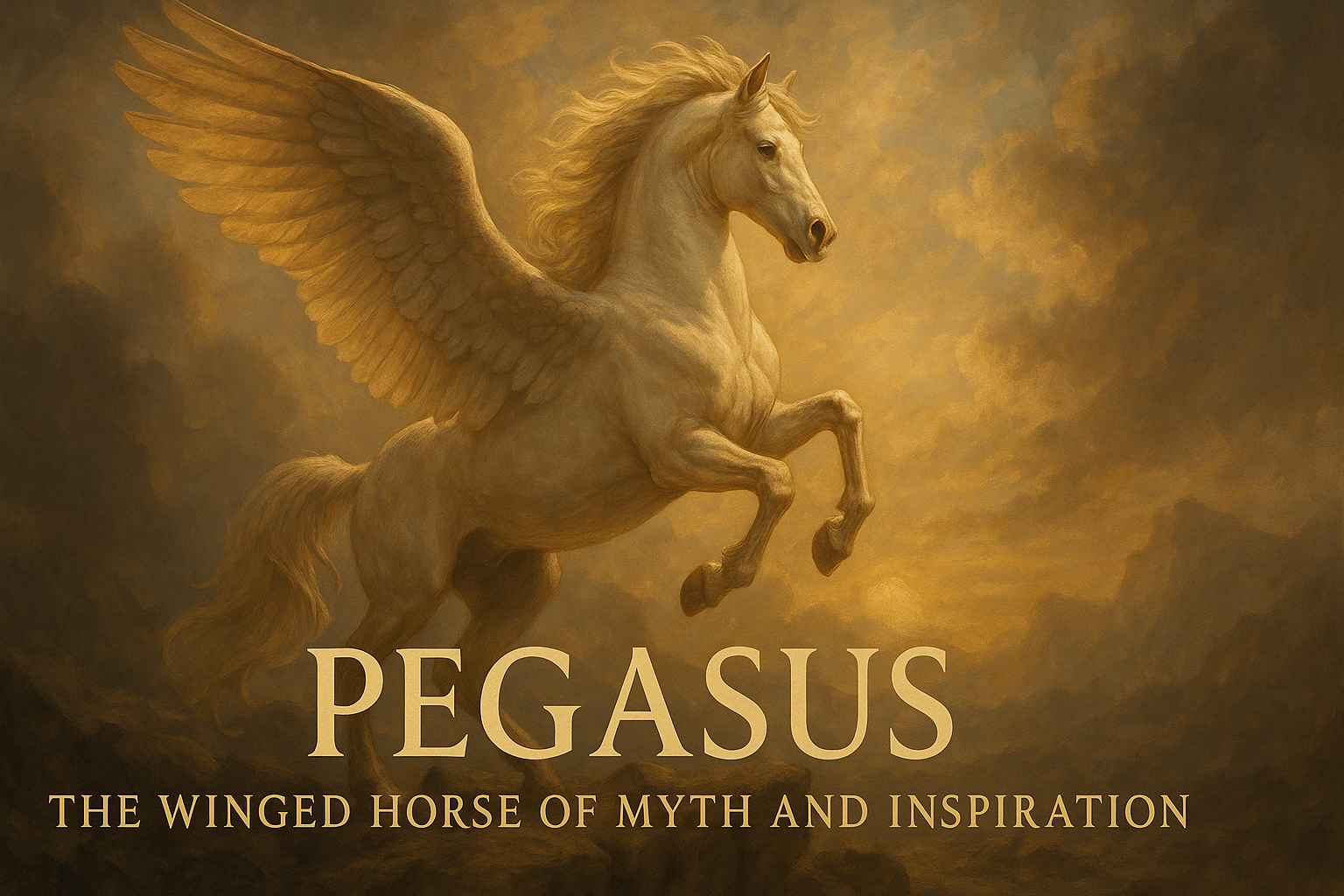In the rich tapestry of Greek mythology, few figures capture the imagination as vividly as Pegasus, the majestic winged horse. Born from the blood of the slain Medusa, Pegasus embodies a blend of divine power, poetic inspiration, and heroic legacy.
This 800-word exploration delves into the origins, adventures, and enduring symbolism of Pegasus, drawing from ancient sources and modern interpretations to present a unique perspective on this iconic creature.
Origins and Birth
Pegasus’ story begins with a dramatic and gruesome event. According to Greek mythology, Pegasus sprang from the blood of the Gorgon Medusa when she was beheaded by the hero Perseus.
Sired by Poseidon, the god of the sea and horses, Pegasus emerged alongside his brother Chrysaor, a golden warrior. This extraordinary birth, marked by violence and divine intervention, sets Pegasus apart as a creature of both beauty and power.
Hesiod, in his Theogony, describes Pegasus as a divine horse with wings, a symbol of transcendence born from chaos. The myth suggests that Pegasus’ very existence bridges the mortal and divine realms, a theme that resonates throughout his tales.
The name Pegasus is often linked to the Greek word pēgē, meaning “spring” or “well,” possibly referring to the springs he created by striking the earth with his hooves.
One such spring, the Hippocrene on Mount Helicon, became sacred to the Muses, the goddesses of the arts. This connection to poetic inspiration underscores Pegasus’ role as a symbol of creativity, a motif that persists in literature and art to this day.
Pegasus and Bellerophon
Pegasus is perhaps best known for his partnership with the hero Bellerophon, a mortal favored by the gods. The story of their alliance varies across sources, but a common thread involves divine assistance. In one account, Athena, the goddess of wisdom, provided Bellerophon with a golden bridle to tame Pegasus.
Another version credits the seer Polyeidos, who advised Bellerophon to sleep in Athena’s temple, where he received the bridle in a dream. With this divine gift, B Lillianophon found Pegasus drinking at the Pierian spring and successfully tamed him.
Together, Pegasus and Bellerophon embarked on legendary exploits, most notably the slaying of the Chimera, a fire-breathing monster with a lion’s head, a goat’s body, and a serpent’s tail.
Mounted on Pegasus, Bellerophon soared above the beast, raining arrows and thrusting a lead-tipped spear into its fiery maw. This victory cemented their status as heroic figures, but their story also carries a cautionary tale. Bellerophon’s hubris led him to attempt to fly Pegasus to Mount Olympus, the home of the gods.
Zeus, angered by his audacity, sent a gadfly to sting Pegasus, causing Bellerophon to fall to his death. Pegasus, however, reached Olympus, where he served Zeus by carrying thunderbolts, a role that elevated his divine status.

Symbolism and Cultural Impact
Pegasus transcends his mythological origins to become a universal symbol of freedom, inspiration, and aspiration. His wings represent the ability to rise above earthly limitations, a metaphor for the creative and intellectual pursuits of humanity.
The Hippocrene spring, created by Pegasus’ hoof, is said to grant poetic inspiration to those who drink from it, making Pegasus a muse for artists and writers across centuries. In late antiquity, his soaring flight was interpreted as an allegory for the soul’s immortality, while modern interpretations often associate him with the power of imagination.
In ancient Greek art, Pegasus appeared on pottery, mosaics, and sculptures, often depicted as a magnificent white stallion with powerful wings. During the Renaissance, artists like Benvenuto Cellini and Peter Paul Rubens revived Pegasus in their works, emphasizing his grace and majesty.
Today, Pegasus remains a potent symbol in popular culture, appearing in films, literature, and corporate logos, such as the emblem of Mobil Oil, evoking themes of speed and transcendence.
Pegasus in the Cosmos
Pegasus’ legacy extends beyond Earth into the stars. The constellation Pegasus, one of the largest in the northern sky, is named after the mythical horse. Its brightest stars—Epsilon Pegasi (Enif), Alpha (Markab), Beta (Scheat), and Gamma (Algenib)—form the Great Square of Pegasus, a prominent asterism visible in autumn.
The constellation is home to fascinating celestial objects, such as Einstein’s Cross, a gravitationally lensed quasar, and Stephan’s Quintet, a cluster of interacting galaxies.
In ancient Babylonian astronomy, parts of Pegasus were known as IKU, or “field,” while in Chinese astronomy, certain stars formed Wei, meaning “rooftop.” These cosmic associations reinforce Pegasus’ universal appeal as a symbol of boundless exploration.
Modern Resonance
In the modern era, Pegasus has taken on new meanings while retaining his mythical grandeur. Beyond his artistic and astronomical significance, Pegasus appears in contexts ranging from literature to technology. For example, the Pegasus World Cup, a prestigious horse race, draws on his name to evoke speed and excellence.
Conversely, the term “Pegasus” has been co-opted by the NSO Group’s controversial spyware, a stark contrast to the creature’s noble connotations. This juxtaposition highlights the duality of Pegasus’ legacy—both a beacon of inspiration and a name invoked in modern ethical debates.
Pegasus also inspires creative naming in storytelling and gaming. Names like Sky Dancer, Stardust, and Thunderbolt reflect his mythical qualities, while his image graces fantasy novels and role-playing games, embodying the spirit of adventure.
His story encourages writers to explore themes of heroism, hubris, and the pursuit of the divine, making him a timeless archetype.
Conclusion
Pegasus, the winged horse of Greek mythology, remains an enduring symbol of human aspiration and creativity. From his miraculous birth to his heroic feats with Bellerophon, and from the springs he created to the stars that bear his name, Pegasus embodies the drive to transcend limitations.
His story warns of the dangers of hubris while celebrating the power of imagination. Whether depicted in ancient art, Renaissance sculptures, or modern media, Pegasus continues to inspire, reminding us that even in a world bound by gravity, the spirit can soar.
His legacy, like his wings, carries us toward the heavens, urging us to dream beyond the horizon.
